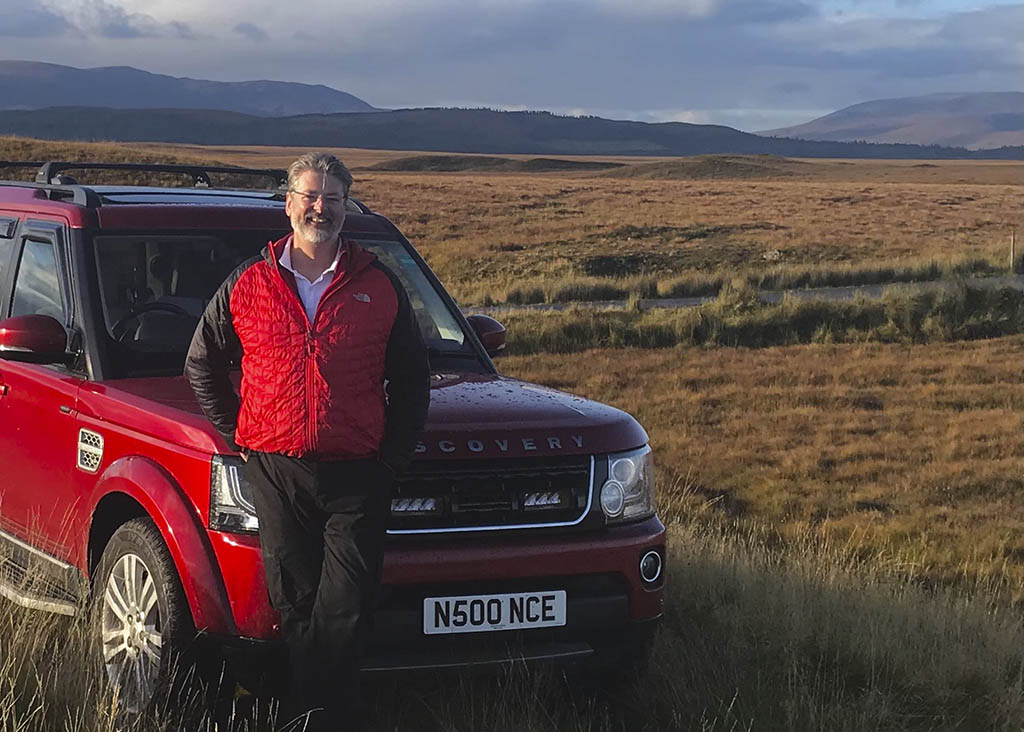
A journey north: Uncover the hidden gems of the far north of Scotland
The benefits of travelling to new places are endless.
Being able to pack up and head off on an adventure to see things you’ve never seen; meet people you never knew existed and tread on new paths is a wonderful privilege.
In my 30 years I’ve managed to tick lots of countries off my travel bucket list-from China and Thailand to South Africa, Canada and the US- but ironically enough, I began 2020 with the ambition to explore more of Scotland, my home. Like everyone, I had no idea the year would bring us face to face with a global pandemic and after months of being cooped up at home, when restrictions began to lift, I was determined to make the most of my freedom.
I felt drawn to the north and began researching where I might stay and explore while I was there. Seeking advice from businesses in the local area I was soon introduced to Rob and Sally-Ann at North Coast Explorer.
The husband and wife team moved to Caithness in 2013. Having visited the area many times on holiday and keen to move away from their tiresome corporate job roles, they initially ran Mey House, a luxury bed and breakfast for five years before deciding to switch their focus to offering bespoke tours to people who wanted to explore the North Coast 500 and various spots inland.

Rob from North Coast Explorer with his noble steed.
Other options for tour guides covering the area are Above and Beyond Tours of Caithness and RobbieMac tours. Above and Beyond is run by two local women, Angela and Isobel with a focus on wellness and creative therapies. Born in Wick and having run a bed in breakfast in Thurso for 17 years, Angela decided to join forces with friend Isobel and use their vast wealth of local knowledge to create unique tours for those keen to explore Caithness. Offering three key tours incorporating everything from historic tombs, coastal walks and picturesque harbours, itineraries can be customised to suit the needs and interests of guests.
Robbie Mac tours offers organised coach tours, driver guided tours (in your own car or theirs) along with a speciality in Scottish and colonial ancestral research and tours. A member of Green Tourism, Robbie Mac tours also practices sustainable tourism. Using their knowledge as locals, the team can highlight hidden gems and share background knowledge you wouldn’t otherwise uncover. There are options for food/drink themed tours, historical, walking and with Visit Scotland having announced 2021 will be the year of coasts and water, it makes touring the north coast all the more appealing.
My decision to go with a guide was based on a few things: I wanted someone who lived in and really knew the area to show me the places those on a self-driving tour might zip past and miss. A gin lover and eager to continue my whisky education I also wanted to visit a few distilleries during my trip, so having a guide to take me safely back to my accommodation after sampling a few drams or G & Ts was much appreciated.
I met Rob at Culgower House (my accommodation for the last night of my trip) in Sutherland where I left my car and hopped in a rather jazzy red land rover which was fully equipped with screens and hand sanitisers to keep us both safe. With all that in mind I was able to sit back and relax right from the word go.
Our first stop was the Helmsdale Memorial, a truly evocative statue erected in memory of the people cleared from the lands during the Highland Clearances 190 years ago. Helmsdale itself was created as a modern village in 1814 to resettle the communities that had been removed from the surrounding straths. Unveiled in 2007, the statue titled ‘The Emigrants’ commemorates the people who left the Highlands and islands to venture beyond Scotland in search of a new home and the impact they have had on those places.
We stopped at Achavanich Stone Setting, a 4000-year-old stone enclosure and the burial site of an important but unidentified woman. I’m a sucker for a good dose of history but when faced with a pile/circle of stones, it can sometimes be tricky to fully appreciate their significance. However, with Rob’s knowledge and knack for storytelling, I was able to view the site in a different way. He also used his iPad to show me an image of what experts believe the woman buried there would have looked like.
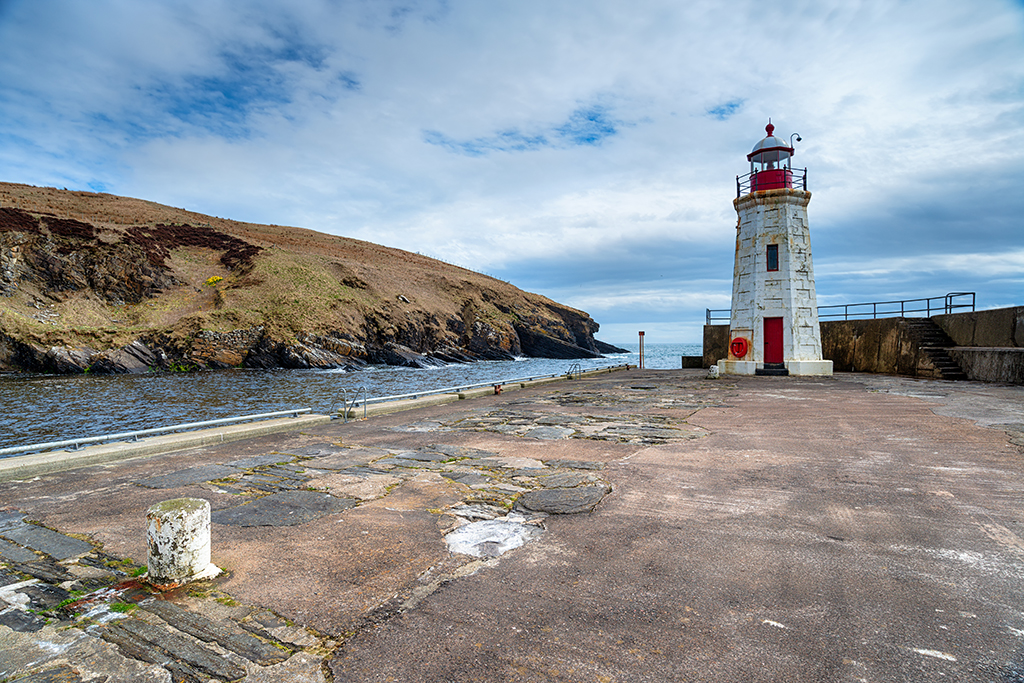
Lybster Harbour was vital to the Herring fishing industry.
While taking in the views of the surrounding landscape we ventured next to Lybster Harbour, a lovely Georgian harbour which was actually used as a film set for the Netflix series ‘The Crown’ last year. Beside the pretty port you’ll also find a café and heritage centre. You can see exactly what the smokehouse would have looked like in the 1800s and learn about the story of the fishing industry and how Lybster was at one time the 3rd largest herring port in Scotland after Wick and Fraserburgh.
From there we also checked out the Camster Cairns and Whaligoe Steps. The cairns are at least 5000 years old and are just three of hundreds of burial tombs spread across the landscape. Due to Covid-19 I wasn’t able to go into the cairn but Rob did his best to explain the structure and to my surprise also had replicas of tools on hand which would have been used across the bronze and iron age. It helped me to imagine the people who would have used and visited the cairns all those years before.
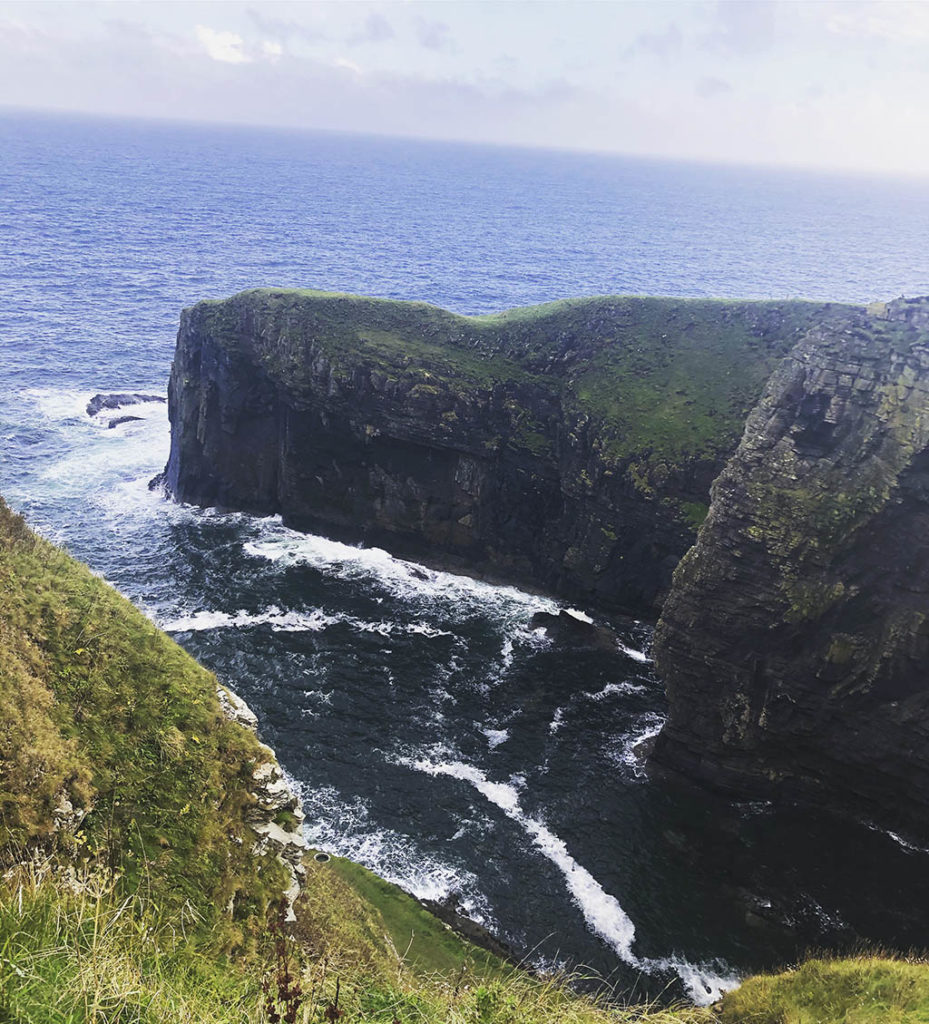
The view from the top of the Whaligoe Steps
The Whaligoe Steps provided yet another spot with a spectacular view. A man-made set of 365 steps that descend to a naturally formed inlet which was once used as a landing place for fishing boats, it was the job of the women to take the herring up those steps to the nearest ice house to be stored. As a reward for conquering the climb, you could treat yourself to a delicious lunch at the Whaligoe Steps café. Owner Karen is of mixed Welsh/Scots/Maltese heritage and prepares a mixture of Scottish and Mediterranean dishes. Unfortunately, it’s closed at the moment due to the pandemic but keep an eye on their website for updates.
My accommodation for the evening was Mackay’s Hotel in Wick. Located on the shortest street in Scotland, the independent business has been run by the same family for 65 years. Purchased by Murray Lamont’s maternal grandmother in 1955, the hotel is now owned and operated by the third generation of Lamonts, Murray and Ellie, along with their daughter Jennifer. There’s a definite feel of tradition about the place and once I’d settled into my huge comfortable room with a view of the Wick river, I trotted downstairs ready to tuck into a mighty dinner in the restaurant No 1 Bistro.
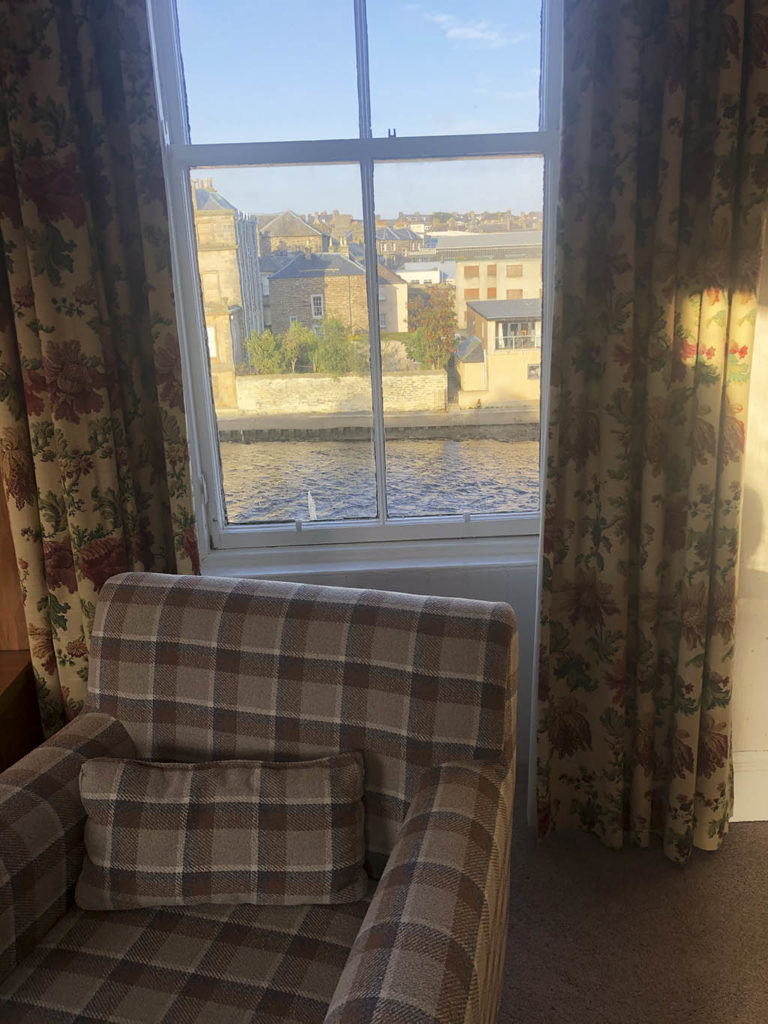
A lovely room with a view at Mackays Hotel
Following an afternoon spent driving around such a spectacular coastline, seeing and hearing the rush of the waves, it felt only right to have some seafood. I opted for the bruschetta with scallops and roasted tomato mousse. Hand dived off the coast of Orkney, the scallops were beautifully cooked and mouth wateringly fresh. Pairing the scallops with the tomato mousse and bruschetta allowed the flavour and quality of the scallops to take centre stage. It was a delightful change to the typical pairing of scallops with black pudding or chorizo. I chose a crisp glass of sauvignon blanc which went perfectly. For my main I chose the grilled duck breast with garlic potatoes and summer vegetables. Tender and succulent, the duck was also served with a sweet beetroot puree. A dish like this could only be enjoyed with a nice glass of red so, putting my trust in one of the friendly waitresses, I soon had everything I needed on a rainy Monday evening in autumn. To finish I decided to go for the decadent chocolate fondant with raspberry sorbet. I could smell it before I saw it, so gloriously chocolatey and warm was the little mound of heaven. The proof was most certainly in the pudding as I broke through the sponge to see a river of chocolate lava flow out on to my plate.
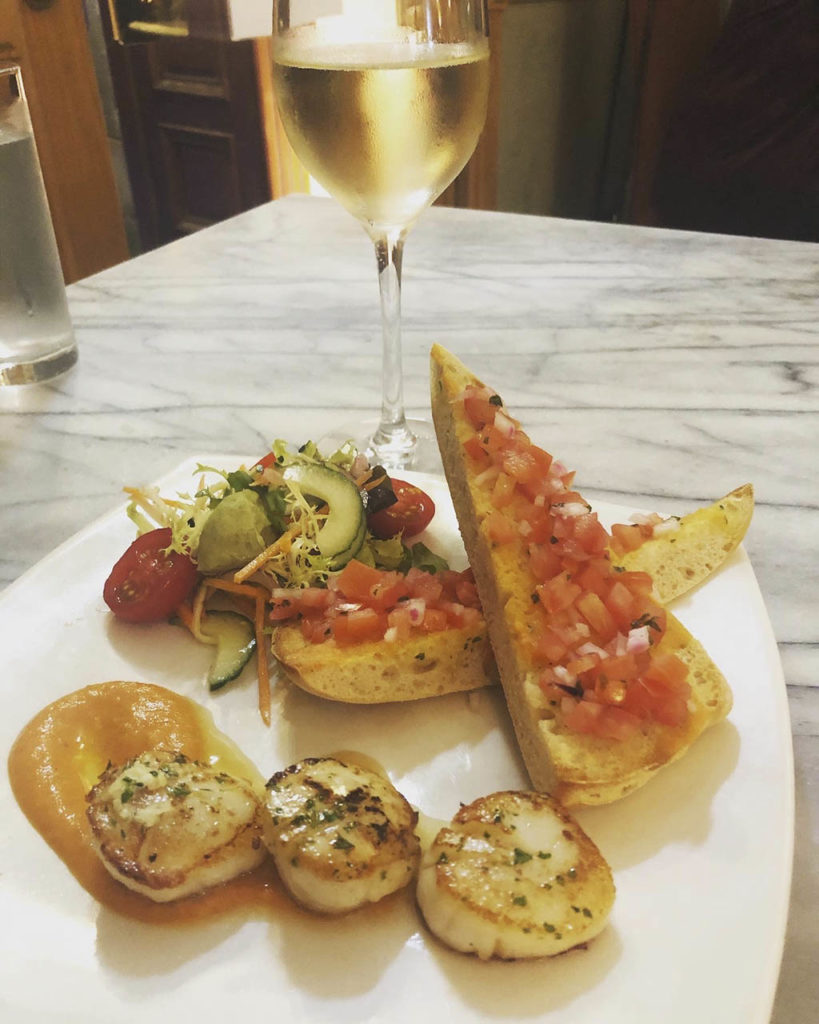
The scallop starter was divine.
I made my way to the bar for a nightcap of Rock Rose gin (made locally in Dunnet) and had a wee chat with some of the staff as things began to wind down for the evening. It was clear from the outset the team who work at Mackays are very close knit, the sense of family extends to everyone. Suitably full and satisfied, I happily made my way up to bed and enjoyed a peaceful night’s sleep.
The next day, with a satisfied tummy after a hearty cooked breakfast, we went to the first castle of my trip. Sinclair Girnigoe Castle sits right on a cliff edge three miles north of Wick and although it’s a ruin, a significant amount of the structure remains intact to give you a sense of how it looked centuries ago. We were joined by local artist Lisa McDonald whose own story of leaving a desk job in London for the wild and open landscapes of the north coast fascinated me. Living in a house with spectacular views of the sea and surrounding coastline and with easy access to the castle and its surrounding walks and trails, it’s easy to see where Lisa gets the inspiration for her paintings from. To view examples of Lisa’s work and find out more vist www.lisamcdonaldart.com
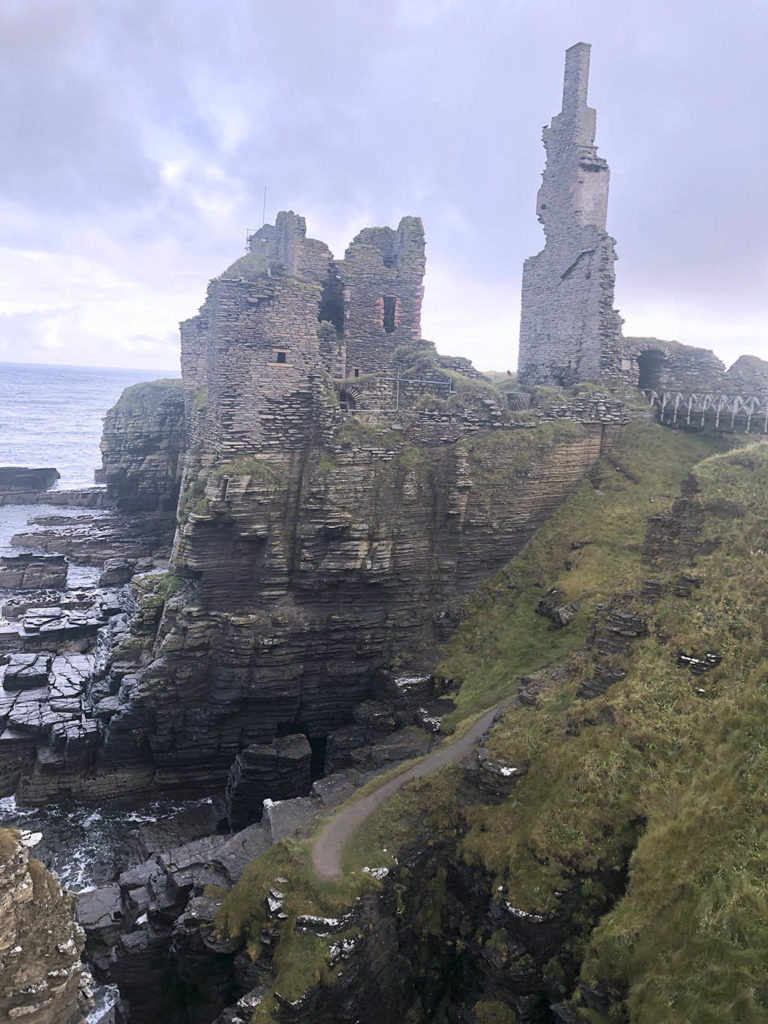
Castle Sinclair Girnigoe is a must see on your trip north
Built around 1470 and modified over the next 200 years, this was once home to the Sinclair earls of Caithness. You must cross a small wooden bridge to access the castle which definitely added to the fairy tale-esque scene. Surprisingly it’s not sign posted very well so unless you have done a bit of research before your trip (or are with a guide) you could miss this stunning spot. This is the case for a few of the places I visited throughout my time on the North East coast, it’s not as curated as other parts of the country. This means it remains unspoiled by hordes of tourists but makes the hidden gems all the more hidden.
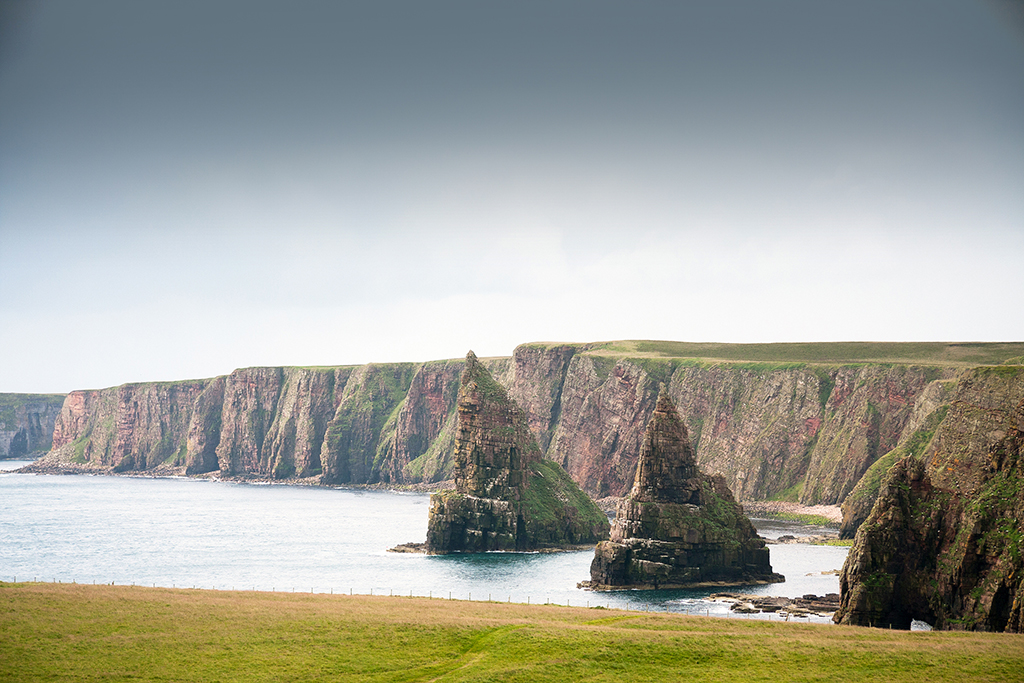
The sea stacks at Duncansby Head.
Of all the sites we visited on my second day – including Keiss Harbour, which was also used as a filming location for ‘The Crown’ and Nybster Broch – the ruined remains of a 2000-year-old dwelling on the eastern sea cliffs – the sea stacks at Duncansby Head and the surrounding walk along the coastline were the most breath taking. After a near miss where I almost fell flat on my behind while walking on the path leading to the sea stacks, I composed myself and managed to reach one of many glorious viewing points. As the sea crashed against the immense stacks and I looked down the steep drop at the rocks and water below, I felt a wonderful sense of peace and calm. After months of worry and stress (which haven’t necessarily reached their end) this was exactly the kind of tonic I needed. I could have stayed there for hours and on a return trip I’ll definitely do just that.
Any trip to the north coast doesn’t quite seem complete without a stop at John O’Groats.
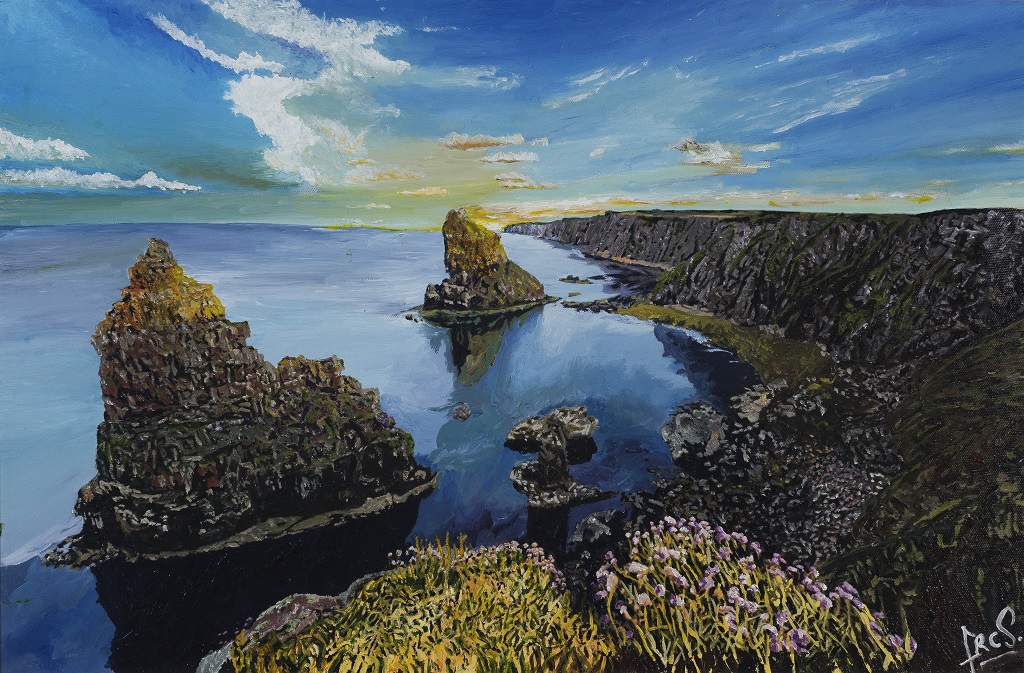
Picture by the sign: check!
With the obligatory photo beside the sign in the bag, it was time to have a nosey in the new shop and visitor centre owned by John O’Groats Brewery. Not only can you pick up their range of ales and stouts plus locally made gin, vodka and rum there but hopefully very soon, you’ll be able to take a behind the scenes tour to learn and see how the beer is made, finishing with a few samples in what I can only describe as the snuggest and most charming wee ‘bar’ I’ve seen in a long time. I was kindly given a sneak peak and a chance to sample their Golden Oat beer. While I wouldn’t describe myself as a keen beer drinker, this lighter brew was a refreshing change and when sipping in such a unique location, it went down all the easier.
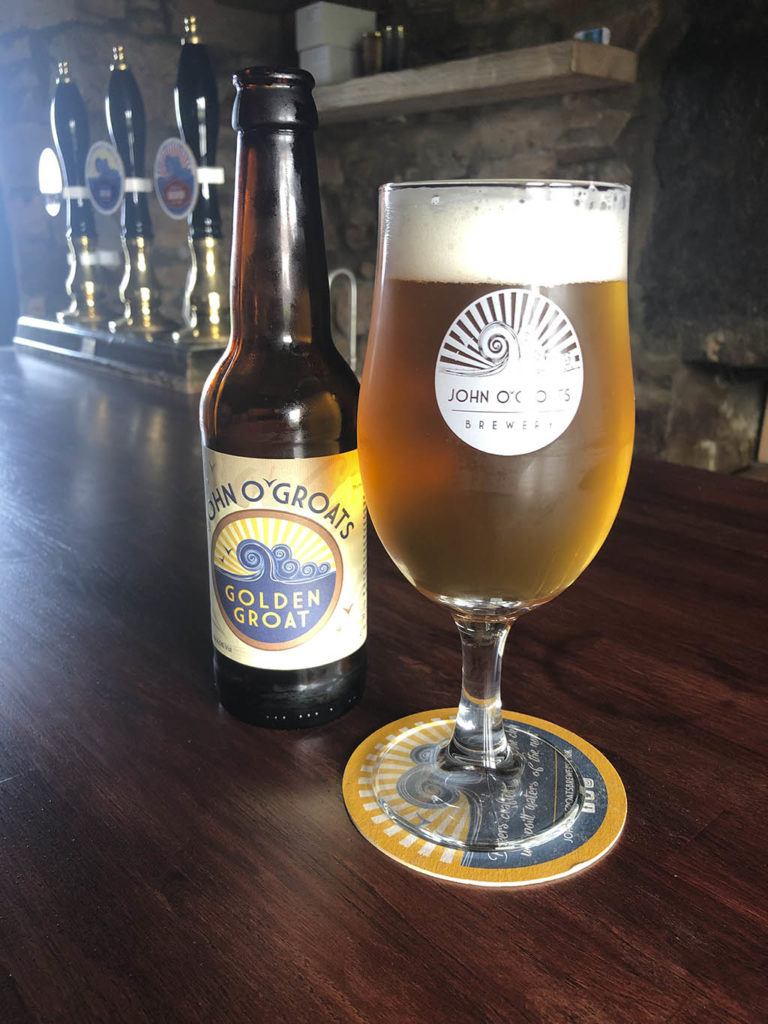
Enjoying a cold one in John o’ Groats Brewery’s new tasting room.
While the rain made a stop at Dunnet Head – the most northerly point on mainland Britain with great views out to the Orkney islands – a washout, the clouds cleared by the time we reached Brough Harbour. Brough itself was a traditional crofting and fishing village until the late 20th century. Rob was on hand to show archival images showing how the bay was used by the community along with the story of the local widow who would come to help divvy up the fish between the men who caught it before being allowed to take her own share away as payment. To my delight a group of seals were hanging out in the shallow waters right by the harbour. With binoculars on hand I could easily see a few seals bobbing their heads above the water and another two lying on the rocks looking rather relaxed and emulating how I feel on a Saturday evening after a Chinese takeaway. Being able to see the wildlife that inhabit this part of the country really enhanced the trip for me and was a way to meet the ‘other’ locals.
There aren’t many things that put a bigger smile on my face than the thought of a lovely gin and tonic, so when it was time to head to the home of Rock Rose gin at Dunnet Bay Distillery, I needed no encouragement. Owned and run by Claire and Martin Murray who started their gin venture in 2014, the distillery also produces Holy Grass vodka. Thanks to the lovely Joanne, the tour and events co-ordinator, I was able to sample the North Coast 500 gin, the navy strength gin (which turned out to be a personal favourite) and the cold brew coffee holy grass vodka – which goes perfectly in espresso martinis and white Russians. There’s a gorgeous tasting room where visitors can be introduced to the different tipples while Joanne guides you through the tasting. Like so many businesses, the team at Dunnet Bay Distillery have had to adapt to the restrictions put in place due to Covid-19 and adapt they have. When visitors come in for a tour and tasting, they have their own gorgeous little boat bench to sit in with a table laden with individual samples in front of it. I was also personally introduced to the two stills responsible for making Dunnet Bay’s liquid goods. Similar to the tradition in shipbuilding, the two stills are named after women who are especially significant to the company. The first is Elizabeth after HM Queen Elizabeth, The Queen Mother who would return to Caithness each year to spend a few weeks at the Castle of Mey. The second still is named after Claire’s mum Margaret who is an integral part of the business as the production supervisor. With a few mini bottles happily clinking in my bag, I left Dunnet Bay Distillery feeling rather pleased.
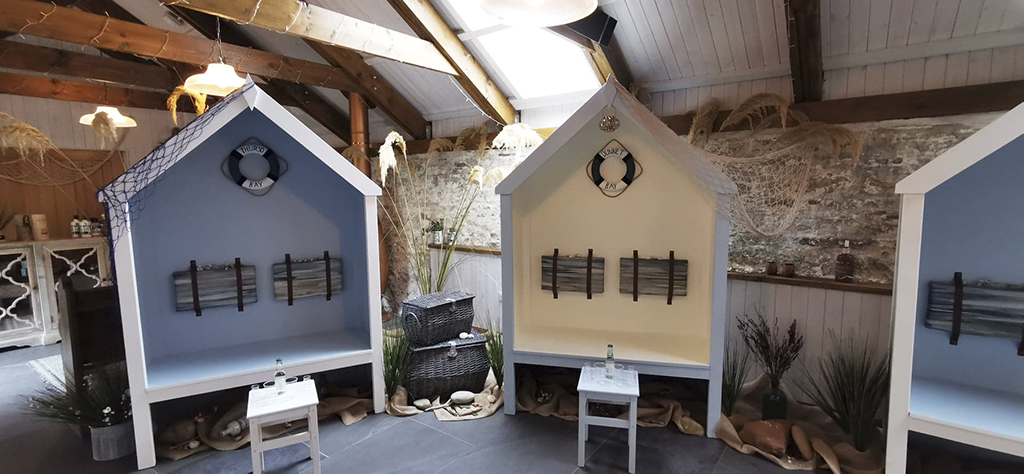
The adorable boat sheds in Dunnet Bay distillery’s tasting room.
My accommodation for the evening was The Granary Lodge bed and breakfast located on the grounds of the Castle of Mey. My room was the perfect cosy bolthole, traditionally decorated and covered in artwork showcasing all manner of sea life. The bathroom was huge and stocked full of Arran Aromatic toiletries which were a delight to use in the luxuriously large shower. Some delicious milk chocolate and a tray of shortbreads, teas and coffees were the perfect accompaniment for me to get ready for dinner.
Along with Sally-Ann, I headed to Scrabster, a small settlement on Thurso Bay to dine at the Scrabster Seafood Bar. Owners Jim and Mary Cowie renovated the old Scrabster Ice House and Salmon Bothy and added the seafood bar, creating what has essentially become the go to place for top quality seafood for locals and beyond. While the more formal restaurant, Captain’s Galley located in the old ice house, is currently closed due to Covid-19, the seafood bar is open for table service and takeaways from Wednesday to Saturday. Although it was a Tuesday night, Jim very kindly agreed to open up the seafood bar just for us and treated us to one of the best dinners I’ve had in a long time.
To begin I chose the Partan Bree or ‘crab soup’ made with local crab and served with oatmeal crackers. Creamy, rich and packed full of deliciously fresh crab meat, it was the perfect warm up to the main event and a glowing sign of what was to come. Sally-Ann chose the mussels served in a sauce of shallots, garlic, white wine and cream which she thoroughly enjoyed. Listening to Jim tell us how he decided to do things back to front by buying a restaurant and going to college to learn how to cook (starting from the very basics) at the age of 52, we tucked into our mains with great fervour. While Sally-Ann enjoyed the classic fish and chips served with peas, I devoured the grilled langoustines which were dripping in a garlic and herb butter and served with chips and mushy peas. The food wasn’t overly fussy or complicated and with the high quality of the ingredients, it really didn’t need to be.
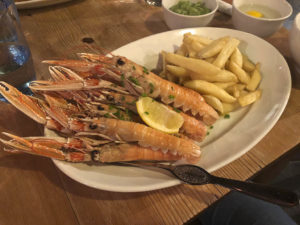
Food glorious food!
Jim comes from generations of fishermen and in the twilight years of his own career in the industry, he could see there was a disconnect between the fish coming in to Scrabster and the local people. Jim and Mary wanted to create a place where guests could enjoy the freshest of fish in a warm and welcoming atmosphere, while physically seeing the boats land the fish as they dine. Having known all the skippers as wee boys, it usually just takes a quick phone call or text and Jim knows what fish he’s going to get and how the restaurant menu will look for the day. At 71, most folk would already have their feet up, but not Jim. ‘As long as I’m able, I will be in that kitchen. I absolutely love it,’ he says. If you do head to the Captain’s Galley and are lucky enough to meet Jim, you’ll see how passionate he is about his business, which he sees as a true labour of love.
The combination of world class seafood, a couple of glasses of crisp white wine and excellent company left me filled with joy and heading to bed with a huge smile on my face.
While the dining and drawing rooms at the Granary Lodge are currently both closed, breakfasts are pre-ordered the night before and delivered in a box to your door at your preferred time. Promptly at 8.30 a friendly face appeared with my feast of berries, natural yoghurt, warm toasted bagel with salmon and dill cream cheese along with fresh apple juice and milk for my coffee. Eating at my leisure as I looked out my window on to views of the coast and cows in the surrounding fields, I felt very content. Ready for the day, I made my way to the Castle of Mey itself for a private tour. Filled with trinkets and treasures the Queen Mother saved over the years, you get a real sense this was a home. There are so many family photographs on display showing more intimate and relaxed moments between the royals which were fascinating to see. While the castle and the walled garden are currently closed, it’s definitely worth adding to your checklist of things to see on your north coast trip.
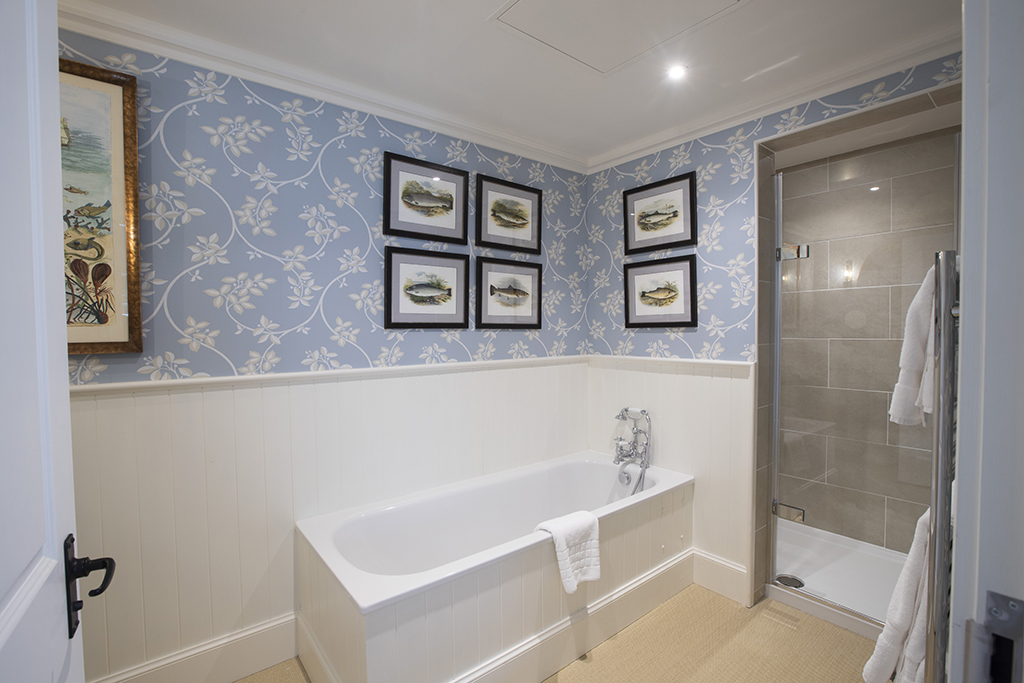
The bathrooms at The Granary Lodge are large and luxurious.
After a delicious lunch platter back at the Granary Lodge filled with potato salad, cheeses, crackers, ham, salad, meat pies and a scotch egg, I was ready to venture to the most northerly distillery on mainland Britain – Wolfburn. Before that, keen to introduce me to local people, Rob made a stop at Keith Parkes showroom and workshop. A furniture maker, Keith’s showroom is a treasure trove filled with lamps, tables, chairs and mirrors all either made from reclaimed pine and wind-blown hardwoods like elm, oak and sycamore or restored. Step outside the workshop and you’ll find his shepherds huts which are built to order while still looking traditional. One of Keith’s more notable customers was HRH Queen Elizabeth, The Queen Mother who personally visited Keith’s workshop to ask if he would restore a chair. The two spoke over a cup of tea and over the following years Keith regularly made or restored items at the request of Her majesty.
Arriving at Wolfburn distillery, we were met by Charlie Ross (the distillery’s tour manager) and distillery manager Iain Kerr. I admit I’ve still a lot to learn when it comes to the amber nectar but Charlie happily answered any questions I had as he guided us through their whisky making process from start to finish. With a history dating back to 1821, the original Wolfburn distillery was the largest in Caithness. It is named after the water source it drew from, ‘burn’ being the Scots word for stream or small river. The new site is actually only a short walk from the remains of the original distillery. While the distillery doesn’t have an extensive visitor centre that others might have, you see the team of staff working around you, giving a greater sense of authenticity and it was both surprising and great to see so many young faces there, demonstrating that whisky is no longer an old man’s game. At the end of the tour, Charlie gave me samples of no less than five whiskies and while I’m trying my best to develop my nose and palate, by the fifth mini dram, I had a lot to say. My favourite of the bunch was the Aurora, a sherried whisky made from spirit laid down in a combination of ex-bourbon and Olorosso sherry casks. I’ve been told the trick with our national drink is to find the one that’s right for you. I think there could actually be a few for me and an offering from Wolfburn might have just made the cut.
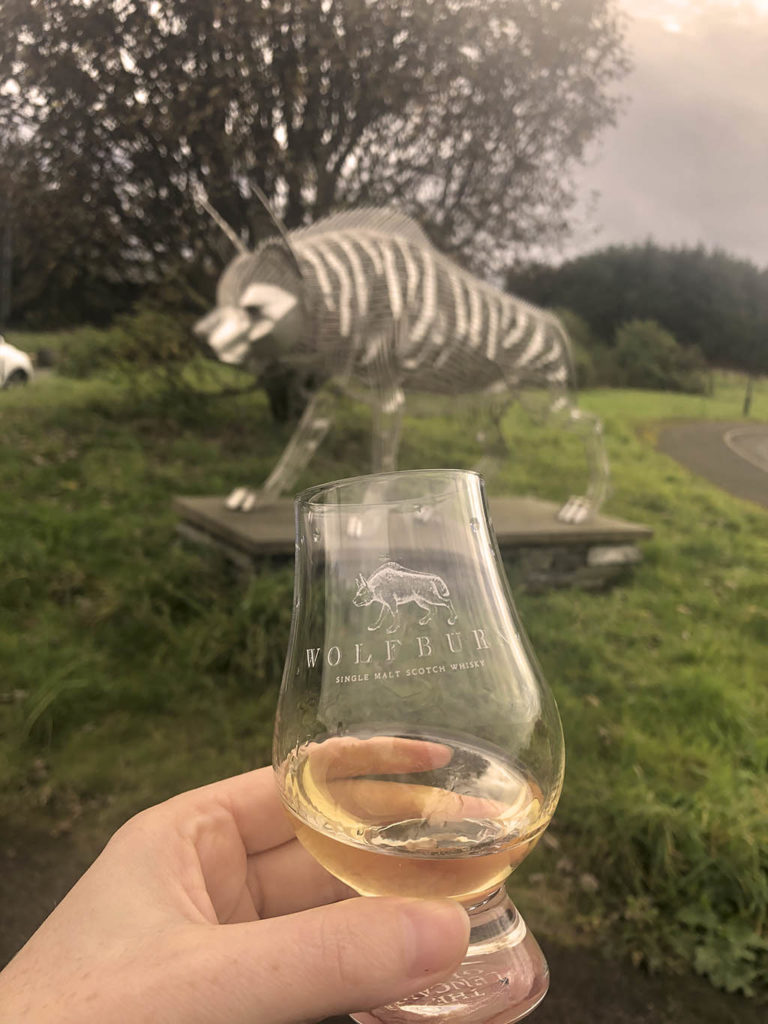
Slainte!
To get to our accommodation for the night we had a fair distance to drive. Travelling along to Dounreay and then down through Croick, Forsinard Flows and Kinbrace, we were heading to Garvault House. The most remote hotel on mainland Britain and nestled in the shadow of Beinn Griam Mor, Garvault is owned and run by Eva and Adrian with help from Olly. The views on our journey through Sutherland were spectacular; vast expanses of peatland, winding roads, lochs both large and small watched over by hills and munros. Seeing these last remaining parts of Scotland’s wilderness was hugely evocative and humbling. The hotel itself is often used as a base for anglers keen to take advantage of the excellent wild trout and salmon fishing in the nearby Helmsdale and Naver rivers.
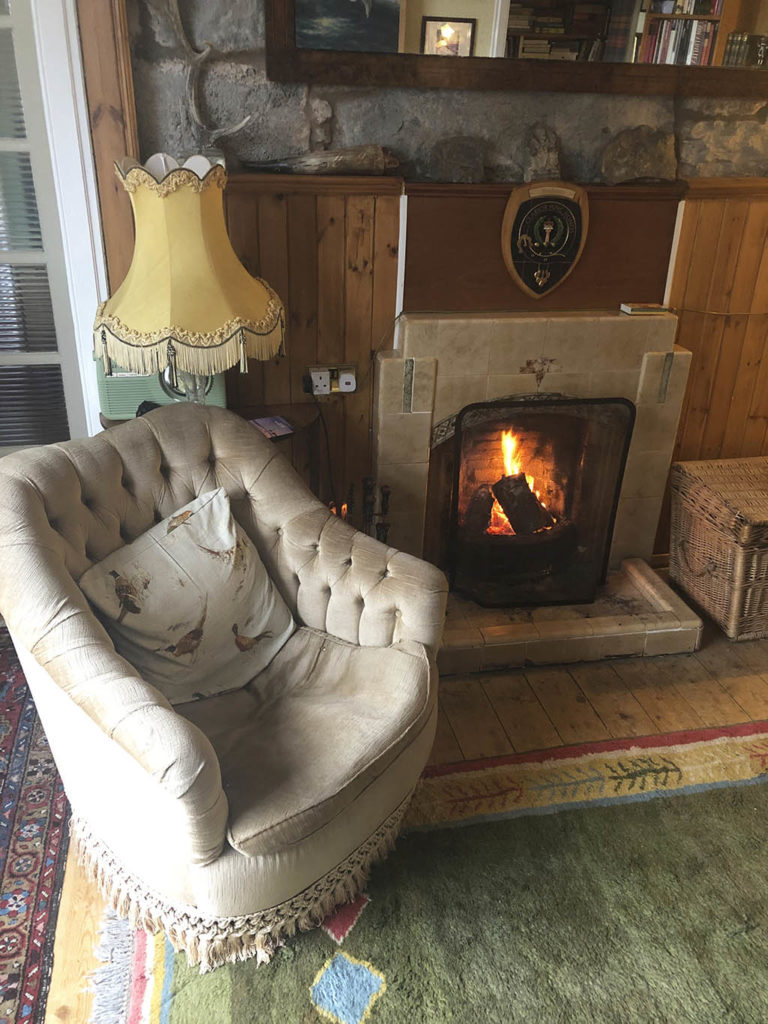
The perfect spot by the fire at The Garvault Hotel.
Arriving at The Garvault, we soon found ourselves sitting by the fire in the library with a pot of tea and a slice of freshly baked apple strudel. Originally from Austria, Eva takes care of the baking and cooking, creating delicious home made and comforting food for guests. After settling in to my homely double en-suite room and having a quick change, it was back in front of the fire for a pre-dinner gin and tonic. Using a range of traditional and locally sourced ingredients including fish, highland venison and vegetables, our dinner was prepared and served in the dining room. We tucked into a starter of toast served with three different pates made with venison, salmon and trout. Packed full of flavour and perfectly seasoned, it was delicious. Our main course was something I can’t believe I’ve never had before: chicken Bonnie Prince Charlie. Cooked in a creamy whisky sauce with flaked almonds and served with rice, it was the perfect meal for a chilly autumn evening. After another night of wonderful food and great company, Eva took us outside to hear the locals making a bit of a racket. The stags who call this part of the world home were roaring at each other as they tried to establish their own territories ahead of the rutting season. Standing in the darkness listening to these magnificent beasts was one of my favourite moments of the trip.
The next morning started with a hearty breakfast of perfectly poached eggs on toast along with locally made jams, marmalades and fresh melon. We ventured to Rosal, a deserted township on the hillside in Strathnaver. There are over 70 ruined stone buildings overlooking Ben Loyal which at one point would have been filled with people, animals and children. Reading from eye witness accounts that Rob had put together, I was able to get a sense of how this communal way of life was swept away (often brutally) by the Sutherland clearances. We then made our way up towards Torrisdale Bay which offered yet more stunning views with its white sand and turquoise (in parts) waters. We went on to Weaver’s Café for a spot of lunch. Tremendously popular with tourists passing through, the café also offers an outdoor eating area with gorgeous views of the surrounding landscape including Coldbackie beach.
A highlight of the day was a stop at Moine House, located between Tongue and Loch Eribol. It was once a halfway house for weary travellers who wanted to rest for the night after travelling across the tricky boggy road. Now just a ruin, an unknown artist has covered the inside of the building with some of the most amazing graffiti I’ve ever seen, including a small portrait of Audrey Hepburn, a beautiful image of a couple in an intimate embrace and appeasing my morbid fascination with horror films, a handful of zombies.
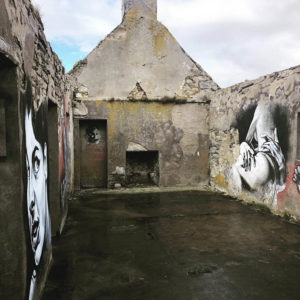
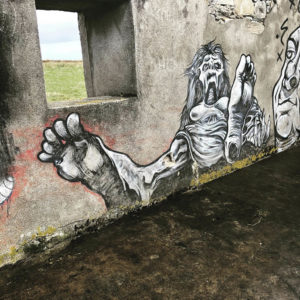
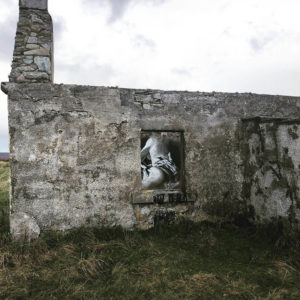
After a scenic drive out to Ard Neackie Viewpoint where the views over Loch Eriboll and the stunning mountainous landscape are amazing, we made our way through Altnaharrah and back down past The Garvault Hotel again. It was at this point we spotted a stag on one of the hills with roughly 20 hinds around him. Using the binoculars, I was able to watch as another stag approached and briefly moved in for a challenge before realising he’d misjudged just how much bigger the first stag was.
After a wonderful moment of feeling like Sir David Attenborough we headed to the end point of my guided trip, Culgower House. Built around 1850, this Victorian townhouse boasts views out over the Moray Firth and nearby beaches. Owners John and Catriona offer a warm and friendly welcome, providing information on things to do during your stay. My room was large, homely and comfortable kitted out in simple traditional décor. Before jumping in to the king size bed I enjoyed a soak in the free-standing bathtub using locally made toiletries. For those chilly days there’s also a sitting room with a wood burning stove and comfortable arm chairs to sink into while reading a book and enjoying some of Catriona’s home baking.
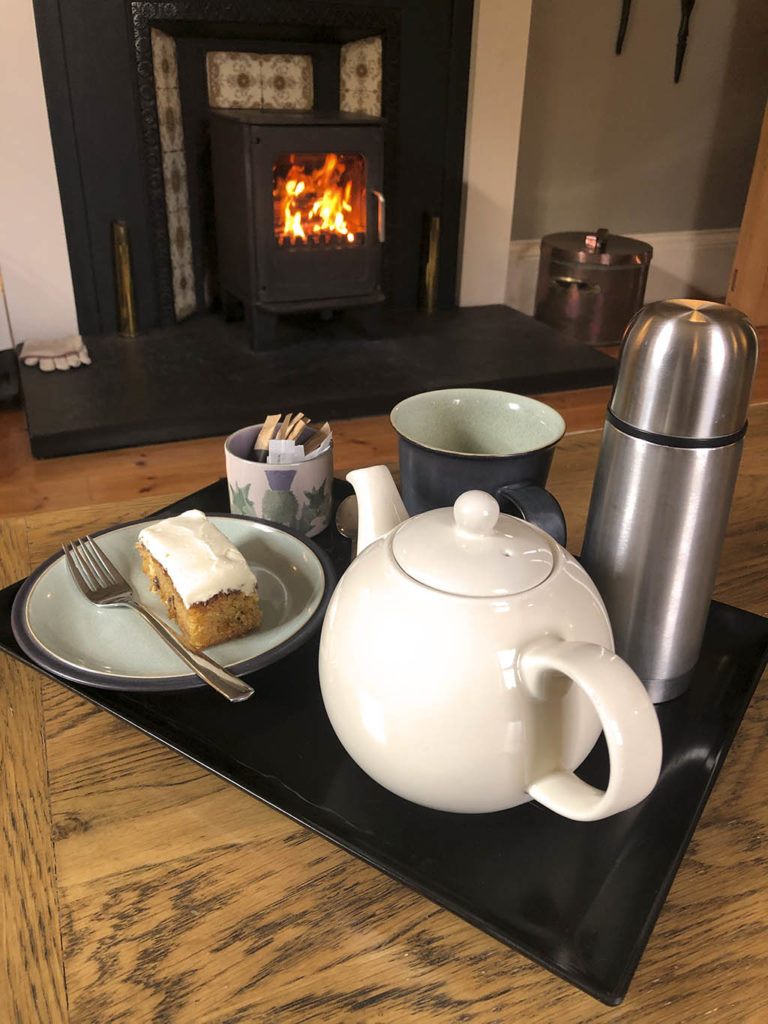
Tea and cake by the fire at Culgower House.
Feeling refreshed and relaxed, I was excited to tuck into breakfast after hearing rave reviews from Rob about Catriona’s skills in the kitchen. With traceability and sustainability being at the heart of so many of the businesses I encountered during my trip, Culgower House was no different. Prepared using local produce as much as possible, my morning feast consisted of roasted mushrooms, tomatoes bacon and sausages, along with fresh apple juice and coffee.
As I headed out on my own to Brora beach (thanks to Catriona’s tip) I could easily see how Culgower would make a lovely base for a trip in the area. Strolling along, listening to the waves and contemplating my adventure as a whole, I felt extremely grateful to have so many wonderful places around me without ever having to leave the country.
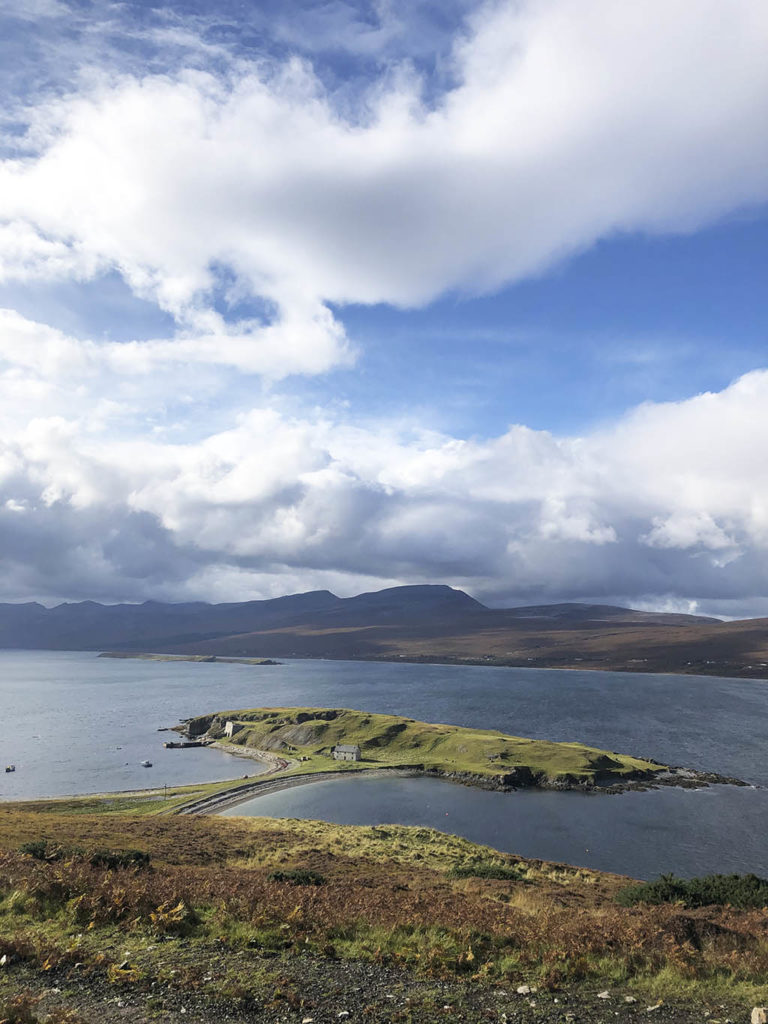
Ard Neackie Viewpoint
I’ve not included everything I saw and did during my trip, although it’s very apparent I had plenty to say. There are things I never would have seen or been aware of without the help of Rob and Sally-Ann at North Coast Explorer, so for their help I’m very grateful.
With such beautiful land and seascapes, delicious food and local people offering the warmest of welcomes, no matter what the year has brought, the far north continues to showcase highland hospitality at its best.
TAGS

